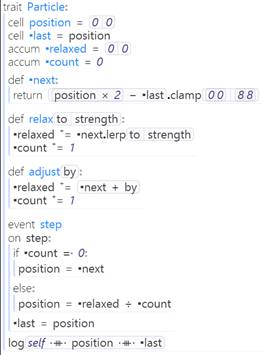Bret Victor: Seeing Spaces
Sean McDirmid
I’m still honestly inspired, but not as impressed as with his previous work. For one thing, this work resembles much of the output I see most designers produce (amazing what one can do with AfterEffects!). A few related projects:
Kato’s Phybots provides an environment for robot programming that relies on a ceiling camera. I’m sure the resemblance is a coincidence.
Microsoft has been playing around with war rooms for programming projects. Basically, it’s a conference room with a bunch of projectors set up; the team works closely together using the screens for communicating updates and doing reviews.
Jonathan Edwards
--
You received this message because you are subscribed to the Google Groups "Augmented Programming" group.
To unsubscribe from this group and stop receiving emails from it, send an email to augmented-progra...@googlegroups.com.
To post to this group, send email to augmented-...@googlegroups.com.
Visit this group at http://groups.google.com/group/augmented-programming.
For more options, visit https://groups.google.com/d/optout.
Sean McDirmid
TED…I thought those were just infomercials?
Recording everything and then mining it a posteriori is Google’s style. I like the idea of a data rich space, but data visualization is actually hard and not so easy to conjure up…what he is proposing is CSI for makers, with the same fictional value as the TV show itself J.
David Barbour
Dmitri Shuralyov
J A Burrows
Sean McDirmid
I didn’t get this out of Bret’s talk, but I agree it is a good feature to have. I’ve been thinking about how to add branching time to Glitch, would allow for multiple “timelines” to exist at one time, possibly with different code. Then it is just a matter of visualizing the differences between different points in time and/or different branches at the same time (and of course, this “just” is an incredibly complicated UX problem).
From: augmented-...@googlegroups.com [mailto:augmented-...@googlegroups.com]
On Behalf Of Dmitri Shuralyov
Sent: Sunday, July 6, 2014 7:18 AM
To: augmented-...@googlegroups.com
Subject: Re: Bret Victor: Seeing Spaces
One short term goal that I get out of this (incredibly inspiring, as always) short talk is:
--
Josh Marinacci
Ian Johnson
Im really excited to hear about a new IDE for arduino, as a software developer toying with arduino it sounds like you are adressing a lot of my complaints :)
I think the key to implementing Bret Victors ideas curently is to do as you say and choose things that are limited in scope or domain specific. Solvong for manageable cases should give us insight to generalization.
Since our laptops are multiple orders of magnitude more powerful than an arduino, could we just send up all of the sketch's state so we could visualize the value of any variable over time? of course calling out the natural inputs from the board make for a great intuitive start, i think seeing what your calculating from those inputs would be great too!
ill check out the IDE! thanks for sharing.
Sandy Klausner
Sean McDirmid
I’m working on a new IDE also, but am doing that concurrently with a Python-like language design. It’s completely live, based on a concept known as managed time. I’m innovating at the presentation aspect, though I think many of my choices will be controversial; e.g.

The editor is free form, not structural, the embellishments come from a smart way of presenting code (it will also inline syntax, type, and even execution errors!). The managed time concept provides for a “steady frame” (see Hancock’s dissertation) that make visualizing state and state changes much easier. The problem with a pure imperative language is that, even if you can record everything, you have no steady frame from which to reason about state changes; “computer time” is entangled with “real time” and transient but benign inconsistencies make the reasoning very noisy.
Jun Kato has done a lot of work related to robotics IDEs; see http://junkato.jp/phybots/
From: augmented-...@googlegroups.com [mailto:augmented-...@googlegroups.com]
On Behalf Of Josh Marinacci
Sent: Monday, July 7, 2014 1:11 AM
To: augmented-...@googlegroups.com
Subject: Re: Bret Victor: Seeing Spaces
I’m working on a new IDE for Arduino and I think it would be a good place to try out some of these ideas.
